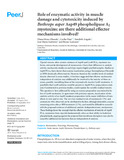Mostrar el registro sencillo del ítem
Role of enzymatic activity inmuscle damage and cytotoxicity induced by Bothrops asper Asp49 phospholipase A2 myotoxins: are there additional effector mechanisms involved?
| dc.creator | Mora Obando, Diana | |
| dc.creator | Díaz Oreiro, Cecilia | |
| dc.creator | Angulo Ugalde, Yamileth | |
| dc.creator | Gutiérrez, José María | |
| dc.creator | Lomonte, Bruno | |
| dc.date.accessioned | 2014-10-01T22:58:13Z | |
| dc.date.available | 2014-10-01T22:58:13Z | |
| dc.date.issued | 2014-09-16 | |
| dc.identifier.citation | https://peerj.com/articles/569/ | |
| dc.identifier.issn | 2167-8359 | |
| dc.identifier.uri | https://hdl.handle.net/10669/11143 | |
| dc.description | artículo (arbitrado) -- Universidad de Costa Rica, Instituto de Investigaciones Clodomiro Picado (ICP). 2014 | es_ES |
| dc.description.abstract | Viperid venoms often contain mixtures of Asp49 and Lys49 PLA2 myotoxin isoforms, relevant to development of myonecrosis. Given their difference in catalytic activity, mechanistic studies on each type require highly purified samples. Studies on Asp49 PLA2s have shown that enzyme inactivation using p-bromophenacyl bromide (p-BPB) drastically affects toxicity. However, based on the variable levels of residual toxicity observed in some studies, it has been suggested that effector mechanisms independent of catalysis may additionally be involved in the toxicity of these enzymes, possibly resembling those of the enzymatically inactive Lys49 myotoxins. A possibility that Lys49 isoforms could be present in Asp49 PLA2 preparations exists and, if undetected in previous studies, could explain the variable residual toxicity. This question is here addressed by using an enzyme preparation ascertained to be free of Lys49 myotoxins. In agreement with previous reports, inactivation of the catalytic activity of an Asp49 myotoxin preparation led to major inhibition of toxic effects in vitro and in vivo. The very low residual levels of myotoxicity (7%) and cytotoxicity (4%) observed can be attributed to the low, although detectable, enzyme remaining active after p-BPB treatment (2.7%), and would be difficult to reconcile with the proposed existence of additional catalytic-independent toxic mechanisms. These findings favor the concept that the effector mechanism of toxicity of Asp49 PLA2 myotoxins from viperids fundamentally relies on their ability to hydrolyze phospholipids, arguing against the proposal that membrane disruption may also be caused by additional mechanisms that are independent of catalysis. | es_ES |
| dc.description.sponsorship | International Centre for Genetic Engineering and Biotechnology (ICGEB, Italy; CRP/COS13-01); Vicerrectorıa de Investigacion (UCR; 741-B4-100). Sistema de Estudios de Posgrado, Universidad de Costa Rica (SEP-UCR). | es_ES |
| dc.language.iso | en_US | es_ES |
| dc.publisher | Peer Journal 2:e569; DOI 10.7717/peerj.569 | es_ES |
| dc.subject | Snake venom | es_ES |
| dc.subject | Myotoxin | es_ES |
| dc.subject | Phospholipase A2 | es_ES |
| dc.subject | Bothrops asper | es_ES |
| dc.subject | Veneno de serpiente | es_ES |
| dc.subject | Pharmacology | es_ES |
| dc.subject | Biochemistry | es_ES |
| dc.subject | Toxicology | es_ES |
| dc.title | Role of enzymatic activity inmuscle damage and cytotoxicity induced by Bothrops asper Asp49 phospholipase A2 myotoxins: are there additional effector mechanisms involved? | es_ES |
| dc.type | artículo original | |
| dc.identifier.doi | DOI 10.7717/peerj.569 | |
| dc.description.procedence | UCR::Vicerrectoría de Investigación::Unidades de Investigación::Ciencias de la Salud::Instituto Clodomiro Picado (ICP) | es_ES |
Ficheros en el ítem
Este ítem aparece en la(s) siguiente(s) colección(ones)
-
Microbiología [1171]


